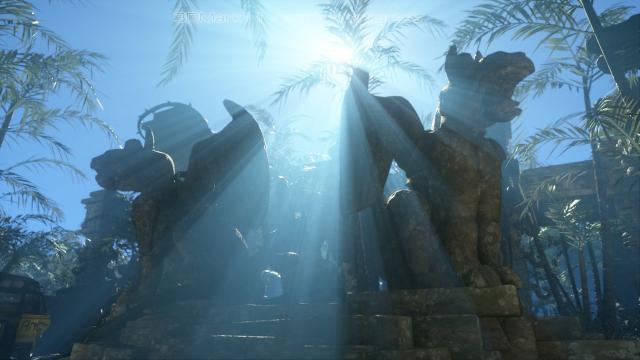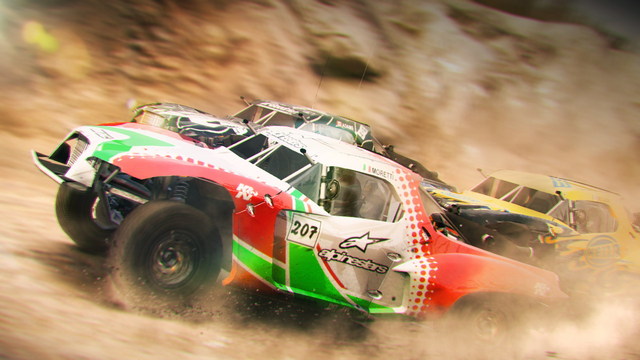|
AMD Radeon HD 7970
The Radeon HD 7970 is the first AMD
card that moves to 28nm fabrication which in laymen's terms means more
transistors can be fitted. Unlike other cards from AMD, the Radeon HD
7979 has almost doubled the number of transistors to 4.3 billion which
equates to a hell of a lot more power. Boasting a maximum resolution of
2560x1600 with the ability to connect three monitors, users should have
no issues with this card, especially considering its 3GB of RAM and
funky architecture.

AMD have also changed their design of the 7900 series with its Graphics
Core Next Architecture. The Graphics Core Next Architecture is a
combination of GPU meets CPU that once again increases the capabilities
of its graphical processing and for gamers, this is means more powerful
gaming. Add in a 384-bit GDDR5 Memory Bus Width, 925Mhz core clock speed
and the world's first card to support Direct 11.1 and the Radeon HD 7970
definitely has quite a few things going for it.
Other technologies with the card include PowerTune and ZeroCore.
PowerTune basically adjusts the clock speeds and power consumption of
the card, whereas ZeroCore basically minimises power output of the card
when it is idle. Two very useful technologies, especially in this green
age. However for the purists, let's have a look as to what actually
makes the HD 7970 grunt with power.
HD 7970
Specifications
Up to 925MHz Engine Clock
3GB GDDR5 Memory
1375MHz Memory Clock (5.5Gbps GDDR5)
264GB/s memory bandwidth (maximum)
3.79 TFLOPS Single Precision compute power
947 GFLOPS Double Precision compute power
GCN Architecture
- 32 compute units (2048 Stream Processors)
- 128 Texture Units
- 128 Z/Stencil ROP Units
- 32 Color ROP Units
- Dual Geometry Engines
- Dual Asynchronous Compute Engines (ACE)
PCI Express 3.0 x16 bus interface
DirectX® 11-capable graphics
- 9th generation programmable hardware tessellation units
- Shader Model 5.0
- DirectCompute 11
- Accelerated multi-threading
- HDR texture compression
- Order-independent transparency
OpenGL 4.2 support
- Partially Resident Textures (PRT)
- Ultra-high resolution texture streaming
Image quality enhancement technology
- Up to 24x multi-sample and super-sample anti-aliasing modes
- Adaptive anti-aliasing
- Morphological Anti-Aliasing (MLAA)
- 16x angle independent anisotropic texture filtering
- 128-bit floating point HDR rendering
AMD Eyefinity multi-display technology1
- Up to 6 displays supported with DisplayPort 1.2 Multi-Stream Transport
- Independent resolutions, refresh rates, color controls, and video overlays
- Display grouping
- Combine multiple displays to behave like a single large display
AMD App Acceleration2
- OpenCL 1.2 Support
- Microsoft C++ AMP
- DirectCompute 11
- Double Precision Floating Point
- AMD HD Media Accelerator
- Unified Video Decoder (UVD)
- H.264
- VC-1
- MPEG-2 (SD & HD)
- MVC (Blu-ray 3D)
- MPEG-4 Part 2 (DivX/Xvid)
- Adobe Flash
- DXVA 1.0 & 2.0 support
- Enhanced Video Quality features
- Advanced post-processing and scaling
- Deblocking
- Denoising
- Automatic deinterlacing
- Mosquito noise reduction
- Edge enhancement
- 3:2 pulldown detection
- Advanced video color correction
- Brighter whites processing (Blue Stretch)
- Independent video gamma control
- Flesh tone correction
- Color vibrance control
- Dynamic contrast
- Dynamic video range control
AMD HD3D technology4
- Stereoscopic 3D display/glasses support
- Blu-ray 3D support
- Stereoscopic 3D gaming
- 3rd party Stereoscopic 3D middleware software support
AMD CrossFire™ multi-GPU technology5
- Dual, triple or quad-GPU scaling
Cutting-edge integrated display support
- DisplayPort 1.2
- Max resolution: 4096x2160 per display
- Multi-Stream Transport
- 21.6 Gbps bandwidth
- High bit-rate audio
- 2560x1600p60 Stereoscopic 3D
- Quad HD/4k video support
- 3GHz HDMI 1.4a with Stereoscopic 3D Frame Packing Format, Deep Color, xvYCC wide gamut support, and high bit-rate audio
- Max resolution: 4096x3112
- 1080p60 Stereoscopic 3D
- Quad HD/4k video support
- Dual-link DVI with HDCP
- Max resolution: 2560x1600
- VGA
- Max resolution: 2048x1536
Integrated HD audio controller
- Output protected high bit rate 7.1 channel surround sound over HDMI with no additional cables required
- Supports AC-3, AAC, Dolby TrueHD and DTS Master Audio formats
AMD PowerPlay™ power management technology3
- Automatic power management with low power idle states
AMD PowerTune technology3
- Intelligent TDP management technology
- Dynamic clockspeed/performance enhancement for games
AMD ZeroCore Power3
- Ultra-low idle power when the system’s display is off
- Secondary GPUs in an AMD CrossFire™ configuration power down when unneeded
AMD Catalyst™ graphics and HD video configuration software
- Software support for Windows 7, Windows Vista, and Windows XP
- AMD Catalyst™ Control Center - AMD Catalyst™ software application and user interface for setup, configuration, and accessing features of AMD Radeon products
- Unified Graphics display driver - AMD Catalyst™ software enabling other PC programs and devices to use advanced graphics, video, and features of AMD Radeon™ products
As you can
see, the Radeon HD 7D 7970 is no slouch when it comes to power and from
these specifications, AMD have definitely cemented the future of video
cards. In order to test the card, we used the following specifications and
compared our benchmarking to Radeon HD 6870 and Radeon HD 5870 cards from
AMD. The following system specifications were used in our testing.
- Intel Core i7-3960X (3.30GHz)
- Asus P8P67-Motherboard
- AMD Radeon HD 7970 (3072MB)
- 2 x 2GB Corsair Memory (DDR 1600Mhz)
- Zenith PSU (750W )
- Seagate 512HB (SATA 6GB/s)
Installation
To install the card, you'll need PCI compliant motherboard, a high-end
power-supply with provisions for 8-pin and 6-pin PCI express connectors.
For additional power, the card supports crossfire in order to connect
the card to another graphics' card or another 7970 for more graphical
power via crossfire.
A special mention should be made about the cooling
features of the 7970 which almost looks quite industrial in design,
especially its size. The heat sink measures around 15.5cm (l), 8.5cm (w)
and 2.5cm (h) and considering that the card is just under 28cm (27.5cm
to be precise) in length, AMD have some serious cooling employed in the
7970.
The last piece of the puzzle is a fan that moves the hot air away
from the cards components and although the fan is relatively silent
while using the operating system, you can hear it whirl up during
intensive gaming like Battlefield 3, especially on warmer days. The card also supports DVI, two
Mini-Display Ports and a HDMI output.
Comparison between older 6800 and 5800 series of graphics cards
| |
AMD Radeon HD 7970 |
AMD Radeon HD 6870 |
AMD Radeon HD 5870 |
| Stream
Processors |
2048 |
1120 |
1600 |
| Texture Units |
128 |
56 |
80 |
| ROPs |
32 |
32 |
32 |
| Core Clock |
925MHz |
900MHz |
850MHz |
| Memory Clock |
1.375GHz (5.5GHz effective) GDDR5 |
1.05GHz (4.2GHz effective) GDDR5 |
1.2GHz (4.8GHz effective) GDDR5 |
| Memory Bus Width |
384-bit |
256-bit |
256-bit |
| Frame Buffer |
3GB |
1GB |
1GB |
| FP64 |
1/4 |
N/A |
1/5 |
| Transistor Count |
4.31B |
1.7B |
2.15B |
| Manufacturing
Process |
TSMC 28nm |
TSMC 40nm |
TSMC 40nm |
Operating System, Movies & Futuremark 3DMark 11 Pro Edition
Windows 7
64-bit automatically detected the card upon installation, however we
installed the official Catalyst drivers for this gaming beast. The clarity
of Windows 7, surfing the net and even using Adobe Photoshop definitely
boasted some great colours. Movies on the other hand were exceptionally nice
with vibrant colours and a perfect frame rate, especially with Blu-ray.
The first
program to test the card was
Futuremark 3DMark 11 Pro Edition which is a staple testing utility of
all testers. This program allows you to test the GPU power of cards,
including the CPU which does reflect real world gaming. As you can see from
results below, the most noticeable improvement was in FULL HD with the card
doubling the results of its older sibling, the Radeon HD 6870.
Futuremark 3DMark 11 Pro Edition (1920x1080)
 2775 (Radeon HD 7970)
2775 (Radeon HD 7970)
 1342 (Radeon HD 6870)
1342 (Radeon HD 6870)
 1601 (Radeon HD 5870)
1601 (Radeon HD 5870)
Gaming
tests
We decided
to test the latest Battlefield 3 game which looked absolutely gorgeous at a
resolution of 1920x1080. From the high resolution texture details to the
extremely smooth gameplay, the only downside was the occasional frame rate
drop which we don't believe was the HD 7970. It was almost 50% faster than
the previous Radeon HD 6870.

Battlefield 3
Battlefield 3 (1920x1080)
 71 (Radeon HD 7970)
71 (Radeon HD 7970)
 41 (Radeon HD 6870)
41 (Radeon HD 6870)
 37 (Radeon HD 5870)
37 (Radeon HD 5870)
Following Battlefield 3 was Crysis 2 which still requires a beast system
to run but the card scored a respectable and quite playable 47 frames
per second. Anything over 30 frames per second works in our books for
Crysis 2 but at 47, we're almost pushing the 60 frames per second. Of
course, you can tweak the settings and drop the resolution but we didn't
want to do that.

Crysis 2
Crysis 2 (1920x1080)
 47 (Radeon HD 7970)
47 (Radeon HD 7970)
 25 (Radeon HD 6870)
25 (Radeon HD 6870)
 19 (Radeon HD 5870)
19 (Radeon HD 5870)
Finally we had DiRT 2, a truly awesome off-road racer that once again
performed extremely well on the HD 7970. At almost 100 frames per second
at FULL HD, this is how car games should be played... awesome graphics
with no tweaking and a silky 91 frames per second. Brilliance!

DiRT 2
DiRT 2 (1920x1080)
 91 (Radeon HD 7970)
91 (Radeon HD 7970)
 60 (Radeon HD 6870)
60 (Radeon HD 6870)
 55 (Radeon HD 5870)
55 (Radeon HD 5870)
Final Thoughts?
Considering that the HD 7970 has the ability of 3.79TFLOPs of graphical
power behind it, it's easy to understand why games performed so well
with this card, especially when linked with its ultra fast memory
performance. With that in mind, as games push around massive amounts of graphical
data, the HD 7970 done a decent job at keeping up.
The card is also
possible to be over clocked and as this was a test card that needed to be
returned, we could not test this feature out. However from other
reports, there have been some impressive improvements from around 10 -
25% so yes, you could reach those elusive frame rates with the HD 7970.
In conclusion, for a single GPU graphics card, the Radeon HD 7970
performed rather well and there was a noticeable difference over the 6800
series of cards from AMD. Just look at the gaming tests that definitely
speak for themselves and if you're looking a card with a considerable amount of
power for gaming, than this card should be taken
into consideration. The only drawback of the card is the price... and
unfortunately in Australia you're looking at around the $700 which is a
little steep in our books. |